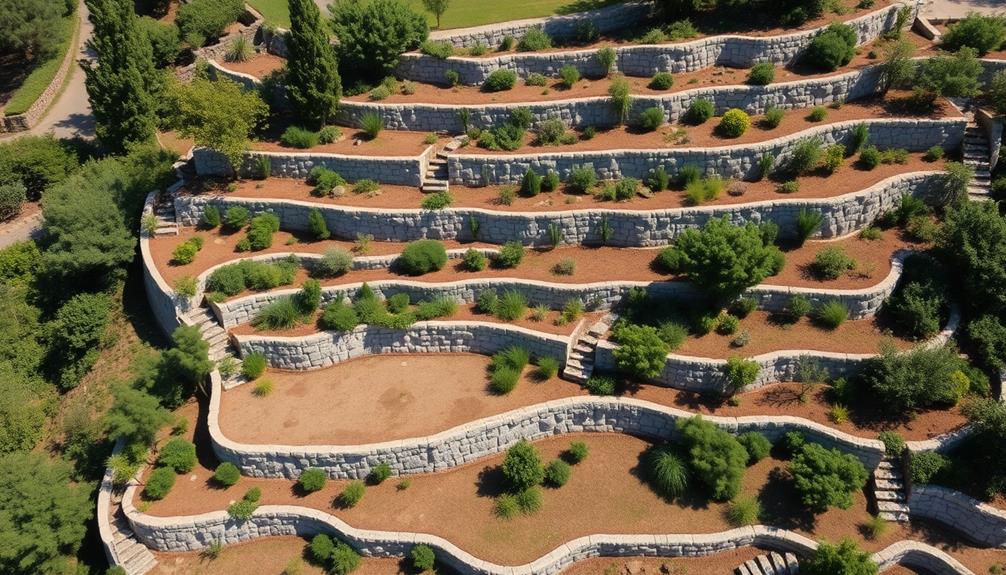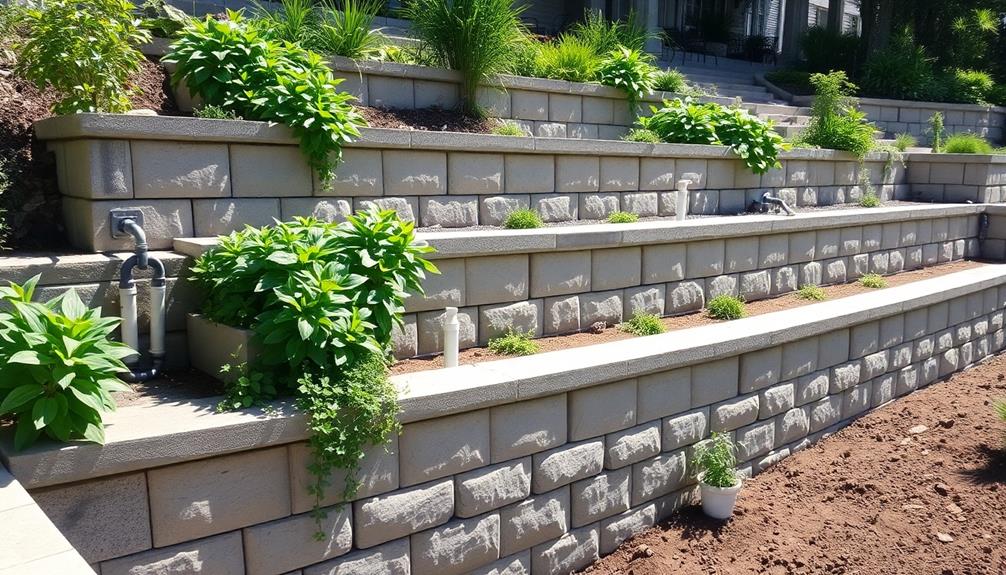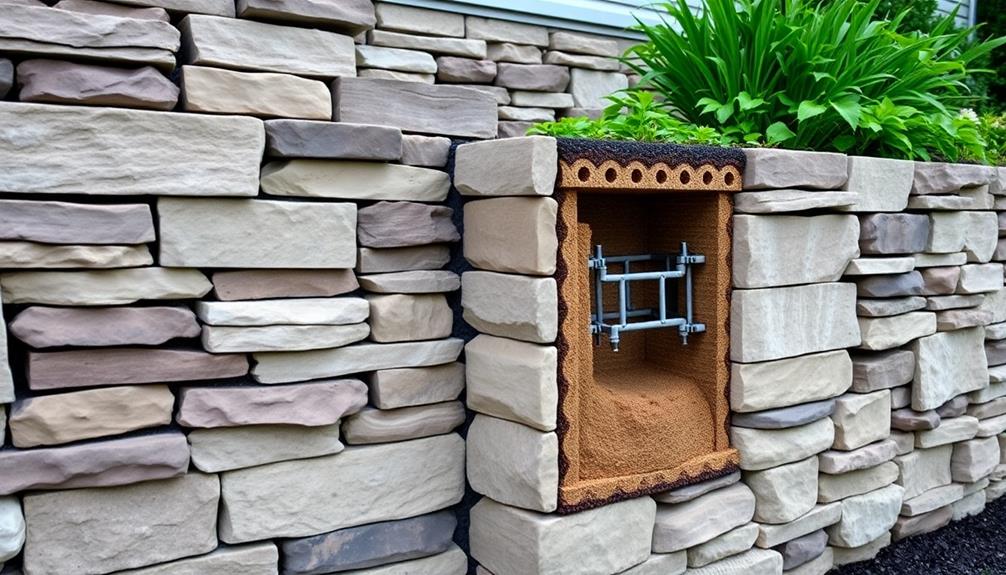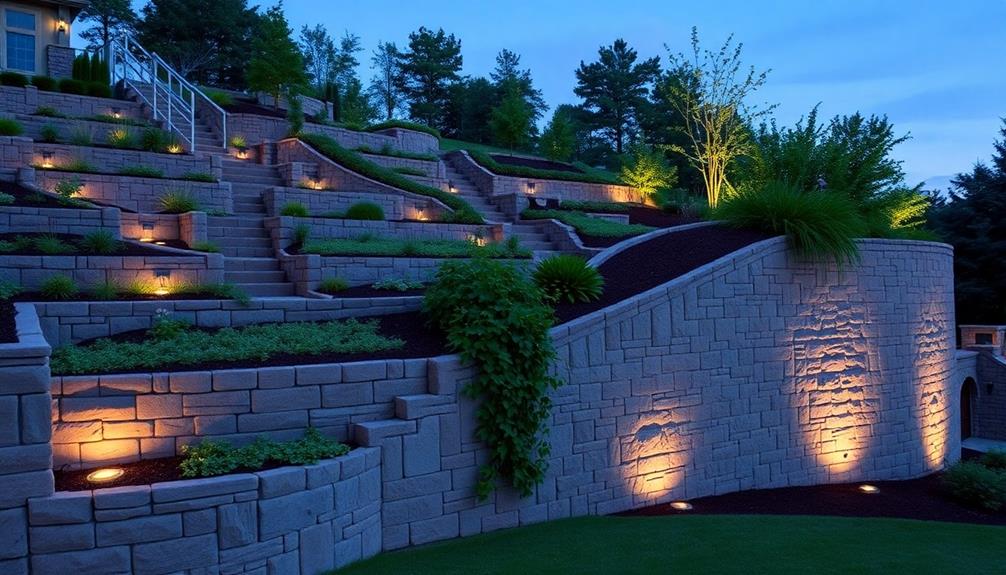Effective retaining wall design requires a meticulous approach that integrates multiple factors. Begin by thoroughly evaluating soil conditions, including composition, moisture content, and bearing capacity. Select appropriate materials based on durability, cost-effectiveness, and aesthetic compatibility with the surrounding environment. Design for stability and safety by determining ideal wall height and thickness, incorporating structural supports, and adhering to local building codes. Integrate the wall seamlessly into the landscape, considering plantings and lighting elements to enhance its appearance. Develop a long-term maintenance plan to guarantee continued performance and structural integrity. By carefully contemplating these elements, you can create a retaining wall that is both functional and visually appealing, with lasting benefits for your property.
Table of Contents
ToggleWalls Contractor Highlights
- Assess soil conditions, including composition, moisture content, and bearing capacity, to inform design decisions.
- Choose appropriate materials based on durability, cost-effectiveness, and compatibility with local regulations.
- Design for stability by determining optimal wall height, thickness, and incorporating structural supports like footings.
- Integrate effective drainage systems to manage water flow and prevent erosion or structural damage.
- Consider long-term performance by developing a maintenance plan and implementing measures to prevent material degradation.
Purpose of Retaining Walls

Retaining walls serve multiple essential functions in landscape architecture and civil engineering. These structures primarily enhance soil stability by preventing erosion and managing soil displacement on sloped terrain, while simultaneously defining property boundaries and creating distinct outdoor spaces.
Retaining wall functions also include creating usable areas for gardening, patios, and parking pads, as well as directing rainwater away from homes. Beyond their practical applications, retaining walls offer significant aesthetic value, allowing for creative landscaping solutions that can transform uneven or challenging terrains into visually appealing and functional areas.
Soil Stability Enhancement
Stability is the primary objective when designing and constructing retaining walls. These structures play a key role in enhancing soil stability, particularly in areas where natural topography or construction activities have created uneven terrain. By effectively managing lateral earth pressures, retaining walls prevent soil erosion, landslides, and structural damage to nearby buildings and infrastructure.
To achieve ideal soil stability enhancement, engineers must carefully consider various factors, including soil composition, groundwater conditions, and external loads. The design process involves selecting appropriate materials, determining wall height and thickness, and incorporating drainage systems to mitigate hydrostatic pressure. Reinforcement techniques, such as geotextiles or soil nailing, may be employed to further strengthen the soil mass behind the wall.
Professional retaining wall design also takes into account long-term performance and maintenance requirements. By implementing proper construction techniques and utilizing durable materials, engineers can safeguard that the retaining wall continues to provide effective soil stability enhancement for years to come. This approach not only protects surrounding structures and landscapes but also contributes to the overall safety and aesthetics of the built environment.
Property Boundary Definition
A property’s boundaries often require clear demarcation, and retaining walls serve as an effective means of achieving this goal. These structures not only define the physical limits of a property but also create a visual barrier that enhances privacy and security. By incorporating retaining walls into landscape design, property owners can establish a distinct separation between their land and neighboring areas, fostering a sense of ownership and belonging within their designated space.
Retaining walls used for boundary definition can be customized to reflect the property owner’s aesthetic preferences while adhering to local zoning regulations and building codes. These structures can be constructed using various materials, such as natural stone, concrete blocks, or timber, allowing for seamless integration with the existing landscape.
When designed thoughtfully, retaining walls can serve multiple purposes beyond boundary definition, including erosion control, creation of usable outdoor spaces, and enhancement of overall property value. By carefully considering factors such as wall height, material selection, and integration with surrounding elements, property owners can guarantee that their retaining walls effectively delineate boundaries while contributing to the overall functionality and appeal of their landscape.
Landscaping and Aesthetics
How can retaining walls enhance the visual appeal of a landscape while serving a functional purpose? These structures not only provide essential support and erosion control but also offer an opportunity to elevate the aesthetic value of outdoor spaces. By incorporating thoughtful design elements and materials, retaining walls can seamlessly blend with the surrounding environment, creating a harmonious and visually appealing landscape.
When considering the landscaping and aesthetics of retaining walls, it is pivotal to select materials that complement the existing architecture and natural features of the property. Options such as natural stone, decorative concrete blocks, or even reclaimed timber can add texture and character to the wall’s surface. Integrating plantings into the design, such as cascading vines or strategically placed shrubs, softens the wall’s appearance and creates a more organic feel.
Terraced retaining walls can be particularly effective in creating multi-level garden spaces, adding depth and interest to sloped areas. Lighting elements, when carefully integrated, can accentuate the wall’s features and extend its visual impact into the evening hours, transforming it into a stunning focal point of the landscape.
Benefits

Retaining walls offer a multitude of benefits that extend beyond their primary structural function. These versatile structures can dramatically enhance landscape aesthetics, creating visually appealing terraces and garden features while simultaneously preventing soil erosion on sloped terrain.
Retaining walls are particularly excellent for stairways and large walkways, providing customizable dimensions and locations to suit various outdoor spaces. In addition, retaining walls increase usable space on properties by transforming steep inclines into level areas, which not only improves functionality but also potentially boosts overall property value.
Improved Landscape Aesthetics
One of the most significant benefits of a well-designed retaining wall is its ability to enhance the overall aesthetics of a landscape. By effectively managing elevation changes and creating distinct levels within a property, retaining walls introduce visual interest and architectural elements that can transform an ordinary outdoor space into an engaging and harmonious environment. These structures serve as focal points, drawing the eye and adding depth to the landscape composition.
Retaining walls offer versatility in design, allowing homeowners and landscape architects to incorporate various materials, textures, and patterns that complement the existing architecture and natural surroundings. Whether constructed from natural stone, brick, concrete, or timber, these walls can be customized to reflect the desired style and ambiance of the property. In addition, retaining walls create opportunities for integrated seating areas, planters, and water features, fostering a sense of intimacy and connection with the outdoor space.
Erosion Prevention
While aesthetic appeal is a notable advantage, the primary function of retaining walls lies in their ability to prevent erosion effectively. These structures play a pivotal role in safeguarding landscapes against soil displacement, particularly in areas prone to heavy rainfall or steep gradients. By strategically designing and positioning retaining walls, property owners can mitigate the risk of soil erosion, which can lead to instability and potential hazards.
Retaining walls act as a formidable barrier against the forces of nature, intercepting surface runoff and redirecting water flow. This interception process substantially reduces the velocity of water, thereby minimizing its erosive impact on the surrounding soil. Additionally, these structures provide essential support to sloping terrain, preventing soil from shifting or sliding downhill. The incorporation of proper drainage systems within the retaining wall design further enhances its erosion prevention capabilities, allowing excess water to be channeled away from vulnerable areas. By implementing these erosion control measures, homeowners and landscape professionals can guarantee the long-term stability and integrity of their property, while simultaneously creating a more resilient and sustainable outdoor environment for their community.
Increased Usable Space
Beyond their erosion prevention capabilities, retaining walls offer a considerable advantage in maximizing usable space on a property. By strategically manipulating terrain, these structures create level areas on sloped landscapes, effectively transforming previously unusable land into functional spaces. This expansion of usable area can be particularly beneficial for homeowners with limited lot sizes or challenging topography.
Retaining walls can facilitate the creation of tiered gardens, expanded patios, or additional parking areas, enhancing both the aesthetic appeal and practical utility of a property. In commercial settings, they can enable the construction of larger building footprints or additional outdoor amenities. The increased space can be leveraged for various purposes, such as installing recreational facilities, creating outdoor living areas, or establishing landscaped zones that elevate property value. Additionally, retaining walls can be designed to incorporate built-in seating or planters, further optimizing the newly created space.
Enhanced Property Value
A well-designed retaining wall can greatly enhance property value by improving both aesthetic appeal and functionality. By incorporating thoughtful design elements and high-quality materials, homeowners can create an attractive focal point that complements the existing landscape and architecture. This visual enhancement contributes to increased curb appeal, which is an essential factor in determining a property’s market value.
Furthermore, a professionally constructed retaining wall demonstrates a commitment to property maintenance and improvement, signaling to potential buyers that the home has been well-cared for. This perception of quality can significantly impact a property’s perceived value and marketability. Additionally, the structural benefits of a retaining wall, such as erosion control and improved drainage, provide long-term value by protecting the property from potential damage and costly repairs.
Real estate professionals often highlight well-executed landscaping features, including retaining walls, as selling points that can justify higher asking prices. The added functionality of increased usable space, coupled with the aesthetic improvements, creates a compelling package that appeals to discerning homebuyers. Ultimately, investing in a properly designed retaining wall can yield substantial returns by elevating the overall value and desirability of the property.
Material Selection and Durability

When designing a retaining wall, selecting the right materials is imperative for ensuring longevity and durability. The choice of materials impacts not only the wall’s structural integrity but also its resistance to environmental factors such as weathering, erosion, and temperature fluctuations. To assist in the decision-making process, consider the following comparison of common retaining wall materials, their durability, and relative costs:
| Material | Durability (1-10) | Weather Resistance | Relative Cost |
|---|---|---|---|
| Concrete | 9 | Excellent | Moderate |
| Natural Stone | 8 | Very Good | High |
| Timber | 6 | Good (with treatment) | Low |
| Brick | 7 | Good | Moderate-High |
Best Materials for Longevity
The longevity of a retaining wall depends considerably on the materials chosen for its construction. When selecting materials for enduring retaining walls, professionals in the field prioritize durability, strength, and resistance to environmental factors. Concrete, particularly reinforced concrete, stands out as a top choice due to its exceptional compressive strength and ability to withstand harsh weather conditions. This versatile material can be customized with additives to enhance its longevity further.
Natural stone, such as granite or limestone, offers both aesthetic appeal and remarkable durability. These materials have withstood the test of time in countless historical structures, demonstrating their resilience against erosion and weathering. For a more economical option that doesn’t compromise on longevity, interlocking concrete blocks provide an excellent alternative. These blocks are designed to distribute pressure evenly, reducing the risk of structural failure over time.
Timber, while not as long-lasting as stone or concrete, can still offer considerable durability when properly treated. Pressure-treated lumber or naturally rot-resistant woods like cedar or redwood can provide a lifespan of several decades when properly maintained and protected from moisture intrusion.
Weather-Resistant Options Explained
Despite the challenges posed by diverse weather conditions, several materials stand out for their exceptional resistance to environmental factors when used in retaining wall construction. Concrete, particularly when reinforced with steel, offers superior durability against moisture, freeze-thaw cycles, and temperature fluctuations. Its versatility allows for the incorporation of water-resistant additives, further enhancing its resilience.
Natural stone, such as granite or limestone, provides an aesthetically pleasing option with inherent weather resistance. These materials withstand UV radiation, acid rain, and extreme temperatures without significant degradation. Engineered composite materials, like geosynthetic reinforced soil systems, combine the strength of traditional materials with innovative polymer technologies, resulting in structures highly resistant to erosion and moisture penetration.
For coastal or high-salinity environments, marine-grade stainless steel components offer unparalleled corrosion resistance. When used in conjunction with weather-resistant aggregates and sealants, these materials create a formidable barrier against salt spray and humidity. Pressure-treated timber, while less durable than inorganic options, remains a viable choice for moderate climates when properly sealed and maintained. Each material presents unique advantages, allowing homeowners and contractors to select the most suitable option for their specific environmental challenges and aesthetic preferences.
Comparing Cost vs. Durability
Selecting the right material for a retaining wall involves carefully balancing cost considerations against long-term durability. Homeowners and contractors must weigh the initial investment against the potential longevity and maintenance requirements of various materials.
Concrete blocks, for instance, offer a cost-effective solution with moderate durability, typically lasting 20-30 years with proper installation and maintenance. On the higher end of the price spectrum, natural stone provides exceptional durability and aesthetic appeal, often lasting 50 years or more, but at a markedly higher upfront cost.
Timber retaining walls present an affordable option with a warm, natural appearance. However, they generally have a shorter lifespan of 10-20 years due to their susceptibility to moisture and insect damage.
Gabion walls, constructed from wire cages filled with rocks, strike a balance between cost-effectiveness and durability, offering excellent drainage and a unique aesthetic. Reinforced concrete, while more expensive initially, provides superior strength and longevity, often lasting 50-100 years with minimal maintenance.
Walls Contractor FAQ
What’s the Average Cost per Square Foot for Building a Retaining Wall?
The average cost for building a retaining wall typically ranges from $20 to $50 per square foot. However, fellow homeowners should note that prices can vary considerably based on materials, location, and complexity of the project.
How Long Does It Typically Take to Construct a Retaining Wall?
The construction time for a retaining wall varies depending on size, complexity, and site conditions. For most residential projects, you can expect the process to take between 1-2 weeks. Larger or more intricate walls may require additional time.
Do I Need a Permit to Build a Retaining Wall on My Property?
Typically, you’ll need a permit for retaining walls over a certain height, usually 3-4 feet. Check with your local building department for specific requirements. It’s best to obtain necessary approvals to guarantee compliance and community harmony.
Can I Build a Retaining Wall Myself, or Should I Hire Professionals?
Building a retaining wall yourself is possible for smaller projects, but hiring professionals is recommended for larger or complex walls. Consider your skills, time, and the wall’s size before deciding. Many homeowners find satisfaction in DIY projects, but safety is paramount.
How Often Should Retaining Walls Be Inspected for Maintenance or Potential Issues?
For ideal safety and longevity, retaining walls should be inspected annually by homeowners and every 3-5 years by professionals. Regular checks help identify early signs of wear, ensuring your wall remains structurally sound and continues protecting your property effectively.







